Rifles in the American Civil War
During the American Civil War, an assortment of small arms found their way onto the battlefield. Though the muzzle-loading percussion cap rifle was the most numerous weapon, being standard issue for the Union and Confederate armies, many other firearms, ranging from the single-shot breech-loading Sharps and Burnside rifles to the Spencer and the Henry rifles, two of the world's first repeating rifles, were issued by the hundreds of thousands, mostly by the Union. The Civil War brought many advancements in firearms technology, most notably the widespread use of rifled barrels.
Background
In the decades leading up to the Civil War, numerous advances had been made in small arms technology. The flintlock, which had been in use for over two hundred years, had been replaced by the caplock in the 1840s. Muzzle-loading rifles had been in use for many years, but prior to the Civil War were issued only to specialist troops. The black powder at the time quickly fouled the barrel, making reloading slower and more difficult since the balls had to be patched and matched closely to the bore size for rifles. Loads used for smoothbore muskets did not need to fit as tightly or be pushed past rifling grooves in the barrel and, therefore, did not suffer from the slow loading problem common to rifles.
The Minié ball solved both of these issues because it was smaller than the bore but expanded on firing. The bores were partially cleaned by the loading process. Black powder also quickly obscured the battlefield, which led military leaders of the time to conclude that the greater range of rifles was of little value on the battlefield. Military leaders therefore preferred the faster-loading smoothbore weapons over the more accurate rifles.
The invention of the Minié ball solved the slow loading problem, allowing smoothbore muskets to be replaced by rifled muskets in the decades just before the Civil War. In addition, most existing military doctrine was based around the smoothbore musket. Since the 17th century, infantry normally fought in a tight shoulder-to-shoulder line and fired volleys at each other. When one side gained the upper hand, they would finish off the attack with a bayonet charge. These tactics developed because smoothbore muskets were only accurate at short ranges. Rifled muskets made this type of fighting obsolete because of their much greater range. In Civil War battles, infantry typically fought using the linear formations (in two-rank company formation), but also took advantage of trees, rocks, buildings, etc. for cover. Infantry units also began to entrench by using their bayonets and cups to dig out shallow trenches. Linear formations were thus rarely seen by late-war battles, as evidenced by the extensive use of trenches and dugouts in the siege of Petersburg.
However, most American army officers in 1861 had been schooled in obsolete Napoleonic tactics, especially since many of them had served in the Mexican War, which was still fought in the old way with smoothbore muskets and linear formations. As such, officers typically failed to realize the power of rifles and continued to launch massed attacks against fortified enemies, which invariably resulted in heavy losses. For years, one of the standard manuals used in the US Army had been an 1835 translation by General Winfield Scott of a French work. Shortly before the Civil War, William J. Hardee (later to become a Confederate lieutenant general) updated it to include information on rifles, but he still assumed the use of linear formations in the book. Nonetheless, Hardee's book was produced in a huge variety of editions during the war, often for different types of infantry. For instance, one was produced specially for African-American troops, and another for Zouave units. There were many Southern editions, and at least one Northern edition that omitted Hardee's name from the title page.
However, historians such as Allen C. Guelzo reject this traditional criticism of Civil War infantry tactics. Casualty estimates compared with expended ammunition from battles indicate 1 casualty for every 250 - 300 shots discharged, not a dramatic improvement over Napoleonic casualty rates. To cite one example, the Battle of Shiloh produced astounding carnage that shocked both the North and South. Over 22,000 men were killed or wounded or in the battle, despite it being early in the war and featuring a high proportion of smoothbore muskets. The Battle of Seven Pines a month and a half later produced some 12,000 casualties in an engagement where numerous smoothbore muskets were in use.
To explain this seeming contradiction between technology and tactical reality, Guelzo points out that even when laboratory tests indicates accuracy with a rifled musket from 600 yards, in an actual battlefield situation, the lack of smokeless powder quickly would obscure visibility. The gunpowder of the time produced a great deal of smoke when fired. Thus, in larger battles, battles began with artillery firing for some time, and skirmishers had been firing at each other for some time. By the time the main lines of infantry began approaching each other, visibility was significantly obscured. Once the infantry began the main engagement, visibility quickly was reduced to almost nil. With the lack of visibility, only massed infantry fire was effective, and this reality is reflected in the tactics of the time. Guelzo argues that rifling only truly benefited the sharpshooters on the skirmish line, who fought before their visibility was obscured, but the main line of infantry could not take advantage of the benefits of rifling.
In addition, due to the rapid expansion of the armies and lack of experienced commissioned and non-commissioned officers, most American volunteer soldiers received inadequate firearms training compared to the smaller professional European armies. Live-fire drills were seldom performed due to the cost of powder and bullets, and many soldiers never properly learned how to use their sights for aiming.
In Gettysburg, the Last Invasion, (Guelzo, Allen C. (2013). Gettysburg: The Last Invasion. Knopf. p. 656. ISBN 978-0-307-59408-2.) Guelzo also points out the technical difficulty of aiming a rifled musket. While rifling improved overall accuracy of muskets, the rifling also formed a trajectory that caused the bullet to quickly "drop" from where it was aimed (in contrast to the flat trajectory of smoothbore muskets). Thus to hit a target at distances beyond 40–50 yards, the rifleman would require knowledge of trajectory and distance, aiming the rifle at a precise angle above the target. In actual battlefield situations, such precise aiming was virtually impossible. Under the stress of battle, virtually every infantryman asked about aiming on the battlefield replied that in practice, the best one could do was "simply raise his rifle to the horizontal, and fire without aiming." (Guelzo p. 62).
Thus Guelzo doubts that contemporary military leaders blatantly ignored technological advances. Rather, Guelzo argued that in actual battlefield conditions, until the development of smokeless powder, the benefits of rifling were largely nullified. Therefore, generals did not neglect to alter their tactics out of ignorance, but because the battlefield had not changed substantially from the Napoleonic era.
Even worse was the state of cavalry tactics. Traditionally, mounted soldiers carried a lance, sword, or pistol and could sweep enemy infantry weakened by artillery or musket fire. Napoleon normally always tried to rout opposing armies from the field after softening their line with massed artillery barrages. The Napoleonic cavalry charge was made both obsolete and suicidal by rifled muskets. At least two major battles in the Civil War, Gaines Mill and Gettysburg, saw such attempts, both with predictable results. As a result, cavalry came to be used mainly for raiding and scouting, and seldom participated in major battles. Mounted charges gave way to dismounted combat where men would hand their horses off to horse-holders and fight on foot.
When the American Civil War broke out in April 1861, neither the North (about 360,000 small arms) nor the South (about 240,000) had enough weapons to fight a major war.[1] Stockpiles of rifles and handguns carried by individual soldiers were limited. As the war escalated those arms stockpiles were quickly diminished.[2] Soldiers were often forced to use older smoothbore and flintlock muskets, which had been considered to be obsolete, simply because the newer rifles were not available in sufficient quantities. Many soldiers were forced to use their own personal hunting rifles, which were typically Kentucky or Pennsylvania type rifles. These rifles, while more accurate than smoothbore muskets, had been designed for hunting, and fired less deadly smaller caliber ammunition.
In April 1861, Virginia militia commanded by Stonewall Jackson occupied the town of Harper's Ferry, Virginia (later West Virginia) and seized the Federal arsenal there. The arsenal boasted state-of-the-art machine tools for manufacturing firearms and the Confederates managed to dismantle all of the equipment and transport it by rail to Richmond and Fayetteville, North Carolina, where it became central to the Confederate war effort.
At the First Battle of Bull Run in July 1861, US Regular Army regiments had Model 1855 Springfield rifles and some companies also had Model 1841 "Mississippi" rifles, however most soldiers in both armies had smoothbore muskets, primarily the Model 1842 musket or percussion-converted Model 1816/1822 musket (as well as some muskets still using the original flintlock mechanism). The only soldiers at First Bull Run who may have had foreign muskets were Wade Hampton's Hampton Legion, as he had ordered Enfield rifles from England to arm it with, however it is unclear if any reached his troops in time for the battle. Late in the year, the first shipments of European muskets began arriving, which included a wide range of weapons ranging from the modern (Model 1853 Enfield rifles) to antiquated ones from the Napoleonic Wars (Model 1809 Potsdam muskets). By early 1862, the first significant deliveries of Model 1861 Springfields began. The regular army received first pick of weapons, followed by the Army of the Potomac. Other Union armies were considered lower priority for receiving the latest and best equipment.
At the Battle of Shiloh in April 1862, the Union armies were fairly well equipped with .58 caliber rifles, however smoothbores were still common along with assorted European muskets such as the M1854 Austrian Lorenz Rifle and Belgian Liege rifles. The Confederates were much worse off, being armed with mostly smoothbore muskets, including some flintlocks, and even shotguns and hunting rifles. Approximately 5400 Confederates at Shiloh had Enfield rifles, and it is recorded that the soldiers of the Kentucky "Orphan" Brigade replaced their flintlock muskets with Enfields dropped by Union troops during the fighting at the Hornet's Nest.
During the Peninsula Campaign, the Army of the Potomac was more than 50% armed with Enfield and Springfield rifles, while the Army of Northern Virginia may have been using close to 40% smoothbore muskets. This may account for the lopsided casualty figures in the Seven Days Battles (15,000 Union casualties versus 20,000 Confederates). By the Battle of Antietam in September 1862, the Army of the Potomac had mostly phased out smoothbore muskets aside from the Irish Brigade, which by choice continued using Model 1842 muskets into 1864. However, ordnance reports show that 40 regiments in the Army of the Potomac still carried .69 caliber muskets at Gettysburg and some as late as the Overland Campaign.
Beginning in the spring of 1863, the War Department required regiments to submit monthly ordnance returns. Information on the weapons that Union regiments carried prior to that time is inferred from various other official documents, letters, regimental histories, and personal recollections of veterans.
The Army of Northern Virginia steadily acquired modern weapons through battlefield pickups, however its chief of ordnance Edward Porter Alexander reported that the Battle of Gettysburg was the first engagement in which the army had no smoothbore muskets. Enfield and Springfield rifles were the primary infantry arms in the Army of Northern Virginia during the second half of the war, along with some Confederate clones of the Springfield such as the Richmond rifle.
In the Western theater, Union armies still carried a significant number of smoothbore muskets into 1863, during the Vicksburg Campaign, Ulysses Grant's Army of The Tennessee had numerous "mule guns" and "pumpkin slingers" (nicknames for inferior shoulder arms). These included a high percentage of Liege rifles and M1809 Potsdam muskets, as well as M1822 and 1842 muskets converted for percussion and often rifling in addition to the "first class" weapons such as the M1861 Springfield. The Army of the Cumberland had a similar situation, and not until the second half of 1863 did the Western armies become uniformly equipped with .58 caliber rifles.
The Confederate armies in the West were much worse off; almost half the Army of Tennessee still had smoothbore muskets at the Battle of Stones River at the end of 1862. By the start of the Atlanta Campaign in spring 1864, the Army of the Tennessee mostly had rifles, although perhaps 15% of its soldiers continued using smoothbore muskets and a few regiments still had them as late as the Battle of Franklin. The Vicksburg garrison by comparison was well-equipped with Enfield rifles at a time when Grant's army still had a high percentage of second class muskets. After the fall of the city in July 1863, Grant's troops were able to rearm themselves with captured rifles.
Late in the war, repeating five and seven shot Spencer and Henry rifles became available to Union troops, mostly cavalry regiments; by the start of the Overland Campaign, the Army of the Potomac's cavalry had virtually standardized on Spencer rifles. The first regiment in the Army of the Potomac to receive Spencer rifles was the 13th Pennsylvania Reserve Regiment, which got them in May 1863 and carried them at Gettysburg. They were used by the Army of the Cumberland at Chickamauga 2-1/2 months later and were more common in the Western armies than the Army of the Potomac. A few repeater rifles were acquired by the Confederates through battlefield pickups, but lack of ammunition made them largely useless. The US government did not purchase Henry rifles, so any soldiers equipped with them would have bought them from private sellers.
To combat the arms shortage, the Union and Confederacy both had imported large quantities of rifles from Europe, with each side buying whatever they could get. The relatively poor South only bought 50,000 by August 1862, while the North bought 726,000.[1] Accordingly, during the first two years of the war soldiers from both sides used a wide variety of rifles, including many that were over 50 years old and were considered obsolete. At the same time, Northern rifle and gun manufacturers such as Sharps, Colt, Remington, and the United States armory at Springfield, Massachusetts quickly increased their production of rifles;[2] Springfield alone increased its annual output from 20,000 to 200,000. The North was thus able to supply its own small arms needs while the South had to continue to rely on foreign sources, eventually purchasing 580,000 rifles.[1]
Modified ammunition types
Various modifications were made to standard rifle and musket ammunition in the Civil War. One such practice with Minie balls was to carve an X in them so the round would expand more when it hit the target. In addition, exploding bullets were occasionally employed by drilling a hole in a rifle bullet, filling it with powder, and attaching a percussion cap to the tip of the bullet. Exploding rifle bullets had been used in European armies for at least 20 years and were primarily designed to target artillery caissons. Smoothbore muskets were occasionally used with glass balls rather than the normal lead ball. Glass musket balls would shatter on impact and fill a wound with pieces of glass that were extremely difficult to remove.
Soldiers who used modified ammunition were putting themselves at considerable risk if taken prisoner, as anyone found with glass musket balls or other such ammunition was liable to be hanged or shot on sight. During the Siege of Vicksburg, the 4th Iowa Regiment sent a note over to the Confederate lines informing them that no prisoners would be taken if they were caught with glass balls. The regimental history of the 15th Iowa recalls an incident where a Confederate drummer boy was captured and nearly executed for having glass balls on him, but someone quickly pointed out that they were marbles and the boy also had no gunpowder with him.
Commonly used infantry arms
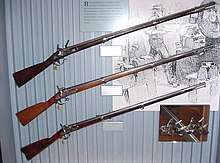
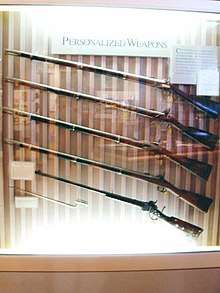
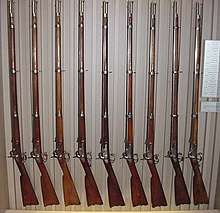
- Model 1816 Springfield (.69 caliber): Produced from 1816 to 1841 with numerous minor updates every few years, and up to 700,000 were made. Originally a flintlock musket, most had been converted to percussion by the time of the Civil War. Muskets made prior to 1821 were considered not worth converting. The Model 1840, the last update, was deliberately designed for easy percussion conversion, but older variants often used haphazard conversions that had poor reliability and huge recoil when fired. Many soldiers detested flintlock conversions and they were widely considered more dangerous to the user than the person being shot at. Nonetheless, they were one of the most common infantry weapons for the first year of the war.
- Model 1841 Mississippi Rifle (.54 caliber): This weapon first gained fame and its unofficial name of "Mississippi Rifle" when Colonel (and future Confederate president) Jefferson Davis led a Mississippi regiment armed with them in the Mexican War. Fairly common in the first year and a half of the war, Confederates continued using them to the end of the war. Many of the existing stock of M1841 rifles by the time of the Civil War had been modified to accept a .58 caliber round.
- Model 1842 Springfield (.69 caliber): The last smoothbore musket adopted by the US Army and the first to be machine-made. About 360,000 were produced between 1842 and 1854. Some were converted to rifling by insertion of a rifled tube in the barrel and the addition of sights; these were commonly referred to as "Minie muskets". These conversions were neither reliable or well-performing, and were far less common than the standard Model 1842. The Palmetto Arsenal in Columbia, South Carolina produced its own version of the M1842 musket with brass rather than iron fittings in the early 1850s, a few thousand of them had been produced when the Model 1855 rifle replaced smoothbore muskets.
- Model 1854 Lorenz Rifle (.54 caliber): The Lorenz Rifle was the Austrian army's standard infantry weapon at the time of the Civil War. Large amounts of them were purchased by both Union and Confederate agents in late 1861-early 1862. Quality was widely variable, and they saw use in most major battles from Shiloh onward. Lorenz rifles were often bored out to accommodate .58 caliber rounds.
- Model 1855 Springfield Rifle (.58 caliber): The first musket adopted by the US Army to use the Minie ball system, the regular army had been fully equipped with them by 1861 and approximately 70,000 produced. A fair number were used by Confederates either from captured stockpiles or battlefield pickups. The M1855 rifle had a complicated, unreliable, and expensive tape primer system that was eventually deleted to create the M1861 Springfield rifle, and many M1855s were modified to use a standard percussion cap.
- Model 1861 Springfield Rifle (.58 caliber): Widely considered the gold standard of Civil War infantry weapons, the M1861 Springfield did not begin significant production until the end of 1861, with deliveries reaching Union regiments early in 1862. The Army of the Potomac was mostly equipped with .58 caliber rifles by late 1862 but the Western armies were slower to upgrade. Confederate troops acquired thousands of M1861 Springfields through battlefield pickups and clones were produced in Richmond and at Fayetteville, North Carolina.
- Model 1809 Potsdam Musket (.70 caliber): Several thousand obsolete Prussian M1809 and M1839 smoothbore muskets were purchased by US government agents in late 1861-early 1862 (the Confederates do not seem to have purchased any Prussian muskets). The M1809 was originally a flintlock musket, however most had since been converted to percussion. Potsdam muskets were mostly distributed to the Western armies and were rare in the Eastern theater. It was not popular due to its size, weight, and sharp recoil when fired, and the lack of appropriate ammunition—Potsdam muskets were used with US-standard .65 caliber cartridges rather than their intended .67 caliber ones, which significantly reduced their accuracy. Many Potsdam muskets were issued to militia, used for training, or kept in storage rather than issued to front line troops.
- Model 1853 Enfield Rifle (.577 caliber): The British M1853 Enfield rifle was imported in large quantities by both the US and CSA and became one of the staples of Civil War infantry, and it saw use in almost every significant engagement of the war from Fort Donelson onward. Both two and three band versions were produced, the latter being vastly more common. Enfield rifles began being imported in the summer of 1861, and it is recorded that the first issues of them to regiments were being made that August. The US government ceased importing new Enfields in late 1863, but as many as a million of them may have been purchased by both sides.
Types
In the Summary Statement of Ordnance and Ordnance Stores on hand, the United States government divided longarms into at least three categories; Rifles, First Class; Breech-Loading Carbines; and Muzzle Loading Carbines. These were specified as follows:[3]
Rifles - first class
- Springfield muskets (hand-written onto form)
- U.S. Rifles, model 1855, Calibre .58
- U.S. Rifles, model 18xx, Calibre .54
- Ballard's Breech-loading Rifles, Calibre .5x
- Colt's Revolving Rifles, Cal. .56
- Merrill's Breech-loading Rifles, Calibre .52
- Spencer Breech-loading Rifles, Calibre unspecified
- Sharps' Breech-loading Rifles, Calibre .52
- Prussian Muskets (hand-written onto form)
- Austrian Muskets (hand-written onto form)
- Enfield Rifles, Calibre .58
- Light French Rifles, Calibre .57
- Hawken rifles
- Allen Falling Block rifle .44
Breech-loading carbines
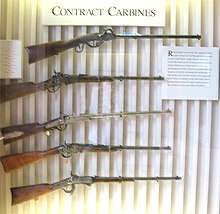
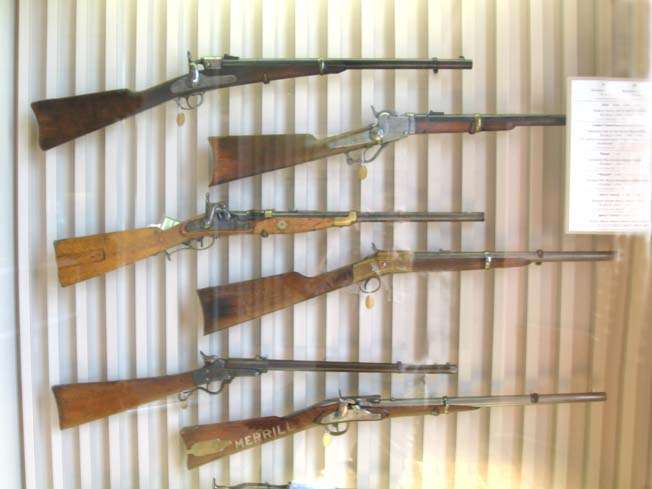
- Ballard's rifled. Cal. .44 (takes metallic cartridge)
- Burnside's rifled. Cal. .50
- Spencer's Cal. .52 (hand-written onto form)
- Cosmopolitan, rifled. Calibre .52 and Gwyn and Campbell carbine
- Joslyn's rifled. Calibre .52
- Gallager's rifled. Calibre .50
- Gibbs' rifled. Calibre .52
- Green's rifled. Calibre .54
- Hall's rifled, Calibre .52
- Lindner's. Calibre .58
- Merrill's rifled. Calibre .54
- Maynard's rifled. Calibre .50
- Sharps' rifled. Calibre .52
- Smith's rifled. Calibre .50
- Starr's rifled. Calibre .54
- Warner Carbine Calibre .56
- Triplett & Scott carbine Calibre .56
- Ball repeating carbine Calibre .50
- Remington split breech Calibre .50
- Lee carbine Calibre .50
- Henry rifle Calibre .44
- Volcanic rifle .44
- Various revolving rifles
- Various stocked revolvers
- Tarpley carbine
- Morse carbine Calibre .54
- Keene carbine Calibre .54
Muzzle-loading carbines
- English Artillery rifled. Calibre
- English Sapper rifled, "Enfield" pattern. Calibre .577
- French Rifled Carbines. Calibre .60
- Pistol Carbine, rifled.
- Musketoons, U.S. XXXX rifled.
- Musketoons, English, smooth-bore.
Springfield rifled musket
This was a single shot, muzzle-loading gun that used the percussion cap firing mechanism. It had a rifled barrel, and fired the .58 caliber Minié ball. The first rifled muskets had used a larger .69 caliber Minié ball, since they had simply taken .69 caliber smooth bore muskets and rifled their barrels. Tests conducted by the U.S. Army indicated that the .58 caliber was more accurate at a distance. After experimenting with the failed Maynard primer system on the Model 1855 musket, the Model 1861 reverted to the more reliable percussion lock. The first Model 1861 Springfields were delivered late in that year and during 1862 gradually became the most common weapon carried by Union infantry in the eastern theater. Western armies were slower to obtain Springfield rifles, and they were not widely used there until the middle of 1863.
Rifles were more accurate than smooth bore muskets, and could have been made using shorter barrels. However, the military was still using tactics such as firing by ranks, and feared that shorter barrels would result in soldiers in the back ranks accidentally shooting front rank soldiers in the back of the head. Bayonet fighting was also important at this time, which also made militaries reluctant to shorten the barrels. The Springfield Model 1861 therefore used a three-band barrel, making it just as long as the smoothbore muskets that it had replaced. The 38-inch-long rifled barrel made it a very accurate weapon, and it was possible to hit a man sized target with a Minié ball as far away as 500 yards (460 m). To reflect this longer range, the Springfield was fitted with two flip up sights, one set for 300 yards (270 m) and the other for 500. Along with a revised 1863 model, it was the last muzzle-loading weapon ever adopted by the US Army.
By the end of the war, approximately 1.5 million Springfield rifle muskets had been produced by the Springfield Armory and 20 subcontractors. Since the South lacked sufficient manufacturing capability, most of the Springfields in Southern hands were captured on the battlefields during the war.
Many older Springfield rifle muskets, such as the Model 1855 and 1842, were brought out of storage and used due to arms shortages. Many smooth bore muskets dating all the way back to the Springfield Model 1812 were brought out of storage for similar reasons. These old and obsolete weapons were replaced by newer weapons as they became available.
Enfield rifle musket
The second most widely used weapon of the Civil War, and the most widely used weapon by the Confederates, was the British Pattern 1853 Enfield. Like the Springfield, this was a three-band, single-shot, muzzle-loading rifle musket. It was the standard weapon for the British Army between 1853 and 1867. Confederate soldiers liked it because its .577 cal. barrel allowed the use of .58 cal. ammunition used by both sides. The Royal Small Arms Factory at Enfield, England, was forbidden to sell arms to the Confederacy, but private contractors who manufactured the weapon under license were not.
Approximately 900,000 of these muskets were imported during 1861–1865, seeing use in every major battle from Shiloh onward. Many officers preferred Springfield muskets over the Enfield — largely due to the interchangeability of parts that the machine-made Springfields offered.[2] But some soldiers liked the Enfield better because its blued steel barrel and fittings did not have to be continually polished to ward off rust like the bright metal of the Springfield did.
The Enfield had a stepped flip-up rear sight, which was adjustable from 100–900 yards (91–823 m) (1,200 yards (1,100 m) in later models) in 100 yard increments. Realistically, though, hitting anything beyond 500 yards was mostly a matter of luck.
Lorenz Rifle
The third most widely used weapon of the Civil War was the Lorenz Rifle. This rifle was invented in 1854 by Austrian lieutenant Joseph Lorenz. This rifle had first seen action in the Second Italian War of Independence.
The Lorenz rifle was similar in design to the Enfield rifle-musket. It used a percussion lock, was similar in length, and had three barrel bands, like the Springfield and Enfield. The Lorenz rifle was originally .54 caliber. A large number were bored out to .58 caliber so that they could use the same ammunition as the Springfield and Enfield rifle-muskets.
The quality of Lorenz rifles during the Civil War was not consistent. Some were considered to be of the finest quality, and were sometimes praised as being superior to the Enfield. Others, especially those in later purchases, were described as horrible in both design and condition. The bored out versions were not consistent in caliber, ranging from .57 to .59. Many of these poorer quality weapons were swapped out on the battlefield for Enfield rifle-muskets whenever one became available.
The Union purchased 226,924 Lorenz rifles, and the Confederacy bought as many as 100,000.[4]
Whitworth Rifle
The Whitworth rifle was designed by Sir Joseph Whitworth, and was manufactured in Manchester, England. The Whitworth rifle featured a unique hexagonal shaped bullet (with a matching hexagonal barrel) that gave it superior accuracy. This rifle was mostly used by Confederate snipers. The accuracy of the Whitworth was often exaggerated, but it was capable of hitting a man sized target beyond 1,000 yards.
Whitworth rifles were equipped with either Enfield style sights or telescopic sights. The telescopic sights were more accurate, but had a reputation for bruising the user's eye due to the rifle's recoil.
Other rifles used
Other rifles used during the Civil War included the British P-1841-Bored Brunswick Rifle (not common), Burnside carbine (used only by cavalry), Henry rifle (very limited issue; many brought privately by individuals), and the Spencer rifle (used almost exclusively by cavalry).
There were also the New Model 1859, 1863, and 1865 Sharps rifles and carbines, single-shot breechloaders. 12,000 rifles were issued to U.S. Army and Navy including to the 1st United States Sharpshooters and 2nd United States Sharpshooters under Hiram Berdan. However, the Sharps carbine was very common, with over 90,000 produced. The rifles differed from each other mainly in the different "actions" they had. Almost all rifles were made with iron barrels, while only some, like the Burnside, used steel, which then was expensive. The Frank Wesson .44 caliber rimfire breech-loader was bought by state governments or individuals, and used almost exclusively by cavalry.[5]
Model 1855 rifles were fairly common. Most of the regular army was equipped with them in 1861, and the Confederates had a few thousand that had been stored in Southern arsenals. They acquired more through battlefield pickups and would use them throughout the war (although the 1855 rifle was eventually replaced in the Union ranks by 1861 Springfields).
The Model 1841 Mississippi Rifle, the progenitor of the Model 1855 and 1861 Springfield, was still used in the Civil War to a fair degree, especially by Confederate non-commissioned officers (NCOs) and sharpshooters.
The Confederacy also produced a variety of weapons itself, standardizing on .58 caliber in 1862. These were usually clones of existing designs and tended to be poor quality due to shortages of raw material and skilled labor. Some such weapons included clones of the Sharps carbine, the Richmond/Fayetteville rifles (a Springfield clone) and imitations of Enfield rifles and musketoons.
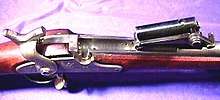
The only breech-loading rifle (not built as a carbine like the Burnside) firing a primed-metallic cartridge (a .50 cal. rimfire) made by the Federal Government (at Springfield Armory) and actually designed for issue to infantrymen was the Model 1865 Springfield Joslyn Rifle, of which only 3,007 were made. In fact, this rifle was the first breechloader ever made in any national armory that fired a primed metallic cartridge. It was basically a Joslyn Carbine action mated to a heavily modified 1863 Springfield barrel and stock. It was issued to disabled soldiers of the Veteran Reserve Corps very late in the war (April 1865) and likely was never used in action. However, it established the single-shot metallic cartridge breechloader as a standard infantry weapon, which eventually all modern armies adopted in one form or another. The US adopted the breechloading 1866 Springfield "Trapdoor" infantry rifle built from surplus rifle-musket parts after the war.
The new repeater rifles would see fairly limited use in the Civil War. The first such weapon used by the US Army was the Model 1855 Colt Revolving Rifle (and a companion carbine), but it had a serious defect in that the gun would sometimes discharge several chambers at once, the extra rounds flying straight into the hand that was holding the barrel up. Some soldiers tried to get around this dangerous problem by loading only one chamber, however this defeated the purpose of having a repeater rifle. Most Colt Revolving Rifles were eventually sold off by the War Department for 55 cents just to get rid of them. The unfortunate experience the army had had with these led to a stigma against repeating rifles, combined with the old fear that they would encourage men to waste ammunition, forcing the already-strained logistical system to provide even more ammunition.
The Spencer rifle was the first successful magazine-fed repeating rifle used by the US Army. After attending a demonstration firing organized by the rifle's designer, Christopher Spencer, President Abraham Lincoln was impressed enough to give it his approval and ordered its adoption. Firing the .56-56 Spencer cartridge, the seven-shot Spencer was produced in rifle and carbine versions; the latter was much more common, as the Spencer saw most of its service with cavalry units. By 1864, some Union companies were armed with them, although rarely whole regiments. A few fell into Confederate hands, but proved largely unusable due to a lack of ammunition (the Confederacy had insufficient supplies of copper to manufacture the Spencer's ammunition). 200,000 were produced between 1860 and 1869, making it the most numerous repeating rifle of the war.
The 1860 Henry rifle saw service primarily with Union infantry during the war, with many soldiers purchasing their own Henry rifle. Though reliable, the widespread adoption of the 16-shot Henry was hindered by its inability to fire powerful ammunition. While most shoulder fired rifles during the time fired a bullet between 350 and 500 grains propelled by 40 to 60 grains of powder, the Henry rifle's .44 bullet was propelled by 26 grains of black powder, giving the Henry relatively short range and hitting power, especially compared to its contemporary, the Spencer, which was much more rugged, durable, and suitable as a military rifle in general. Despite its flaws as a military rifle, 15,000 Henrys were produced, and, when its high capacity and ability to fire rapidly were proper exploited, it could be devastating, as was the case at the Battle of Nashville.
Notes
- Keegan, John (2009). The American Civil War: A Military History. Vintage Books. p. 75. ISBN 978-0-307-27314-7.
- Barnett, Bertram. "Civil War Small Arms". National Park Service. Retrieved 14 July 2008.
- SUMMARY STATEMENT of Ordnance and Ordnance Stores on hand in the Cavalry Regiments in the Service of the United States during the Second quarter ending June 30, 1864, p. 88
- "Civil War Firearms: Their Historical Background and Tactical Use" By Joseph G. Bilby
- Smith, G. (2011). Civil War Weapons. New York City: Chartwell Books, Inc.
Union Battles and Armies were named after geographical locations on a map i.e., Army of the Potomac, Army of the Tennessee. Confederate Armies were named for the state they were formed/served in such as the 37th Georgia Regiment was part of the Army of Tennessee. and battles were named after the nearest town i.e., Battle of Manassas Junction named by the South was also The Battle of Bull Run Creek in the North. C.W. Cason, Civil War Re-enactor and Historian.
References
- Bilby, Joseph (2005). Civil War Firearms: Their Historical Background and Tactical Use. Da Capo Press. ISBN 978-0-306-81459-4.